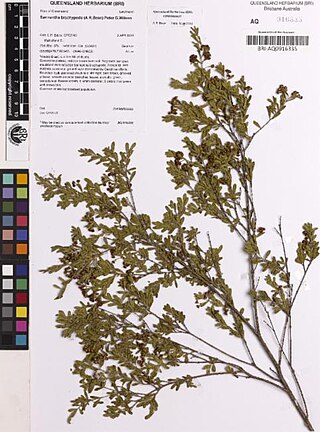
Hypocalymma angustifolium, commonly known as white myrtle, or pink-flowered myrtle, is a species of flowering in the myrtle family Myrtaceae, and is endemic to the south west region of Western Australia. The Noongar peoples know the plant as koodgeed or kudjidi. It is an erect, multi-stemmed shrub with narrowly linear leaves, white or pale pink flowers.

Melaleuca ryeae is a plant in the myrtle family, Myrtaceae and is endemic to the south west of Western Australia. It is a small shrub, closely resembling Melaleuca amydra with its small leaves and profuse heads of pink to purple flowers but M.amydra has narrower leaves and does not have spherical clusters of fruits.

Beaufortia bicolor, commonly known as Badgingarra beaufortia, is a plant in the myrtle family, Myrtaceae and is endemic to Southwest Australia. It is a densely branched shrub with rough, peeling bark, elliptical, upward pointing leaves and heads of red, orange and yellow flowers in November or December. It has been classified as a "poorly known" species.

Rinzia orientalis, commonly known as desert heath-myrtle, is a species of flowering plant in the family Myrtaceae and is endemic to south-eastern Australia. It is a shrub with elliptic to narrowly oblong leaves and white or pale pink flowers usually with ten stamens.

Calytrix brevifolia is a species of flowering plant in the myrtle family Myrtaceae and is endemic to the west of Western Australia. It is a glabrous shrub with egg-shaped, linear, elliptic or more or less round leaves and clusters of pink to magenta flowers with about 40 to 90 yellow stamens in 4 rows.

Hypocalymma asperum is a species of flowering in the myrtle family Myrtaceae, and is endemic to the south west region of Western Australia. It is an erect, multi-branched or spreading shrublet, with relatively short, stout leaves, and rose pink flowers.
Hypocalymma connatum is a species of flowering in the myrtle family Myrtaceae, and is endemic to Western Australia. It is a shrub, with narrowly egg-shaped leaves, probably white flowers, but has not been collected since 1935.

Hypocalymma cordifolium is a species of flowering plant in the myrtle family Myrtaceae, and is endemic to the south west of Western Australia. It is usually an low-growing shrub, but is sometimes erect, with winged stems, heart-shaped leaves arranged in opposite pairs, white or pale pink flowers mostly arranged in pairs in leaf axils, and fruit containing pearly white or pale brown seeds.

Hypocalymma elongatum is a species of flowering plant in the myrtle family Myrtaceae, and is endemic to the south west of Western Australia. It is a large, bushy shrub with linear leaves more or less triangular in cross section, and pink flowers arranged in pairs in leaf axils with 30 to 50 stamens.
Hypocalymma ericifolium is a species of flowering plant in the myrtle family Myrtaceae, and is endemic to the south west of Western Australia. It is an erect shrublet with linear leaves that are more or less triangular in cross section, and bright yellow flowers arranged in pairs in leaf axils with 30 to 50 stamens.

Micromyrtus monotaxis species of the family Myrtaceae and is endemic to the Western Australia. It is an erect shrub with egg-shaped leaves with the narrower end toward the base, white flowers 4.5–6.0 mm (0.18–0.24 in) in diameter, and 10 stamens.
Thryptomene globifera is a species of flowering plant in the family Myrtaceae and is endemic to western areas of Western Australia. It is a shrub with crowded, upward-pointing, broadly egg-shaped leaves with the narrower end towards the base, and pale pink or mauve flowers with ten stamens.
Thryptomene hubbardii is a species of flowering plant in the family Myrtaceae and is endemic to a small area in the west of Western Australia. It is a spreading shrub with crowded broadly egg-shaped leaves with the narrower end towards the base, and flowers with five pale pink petals and nine or ten stamens.
Thryptomene johnsonii is a species of flowering plant in the family Myrtaceae and is endemic to a restricted area of Western Australia. It is a bushy shrub with rigid branches, egg-shaped leaves with the narrower end towards the base and pink flowers with five petals and usually eight stamens.

Babingtonia cherticola is a species of flowering plant in the family Myrtaceae and is endemic to the southwest of Western Australia. It is an erect shrub with linear leaves and white or pale pink flowers in groups of up to three, each flower with 16 to 26 stamens.
Babingtonia erecta is a species of flowering plant in the family Myrtaceae and is endemic to the southwest of Western Australia. It is an erect shrub with densely clustered, linear leaves and white or pale pink flowers in groups two to seven in leaf axils, each flower with 8 to 14 stamens.
Babingtonia maleyae, commonly known as the Narrogin babingtonia, is a species of flowering plant in the family Myrtaceae and is endemic to the southwest of Western Australia. It is a compact shrub with narrowly egg-shaped to elliptic leaves and white flowers usually arranged singly in leaf axils, each flower with 17 to 20 stamens.
Babingtonia urbana, commonly known as coastal plain babingtonia, is a species of flowering plant in the family Myrtaceae and is endemic to the southwest of Western Australia. It is a shrub with linear leaves and white or pale pink flowers usually arranged singly in leaf axils, each flower with 16 to 20 stamens in a circle.

Sannantha brachypoda is a species in the myrtle family, Myrtaceae and is endemic to central Queensland in Australia. It is a shrub with egg-shaped leaves, the narrower end towards the base, and groups of 3 white flowers arranged in leaf axils.

Sannantha collina is a species in the myrtle family, Myrtaceae and is endemic to eastern in Australia. It is a shrub with lance-shaped leaves and groups of 3 to 7 white flowers arranged in leaf axils.












